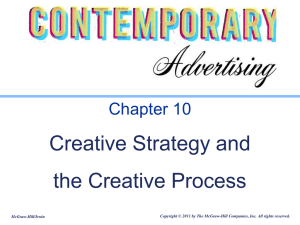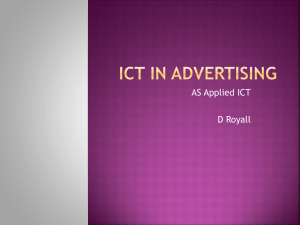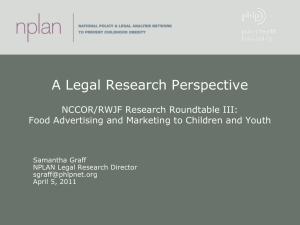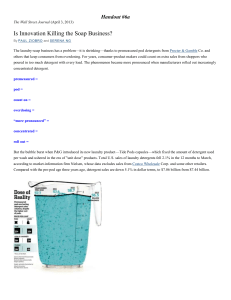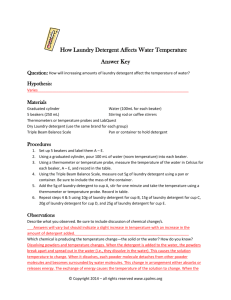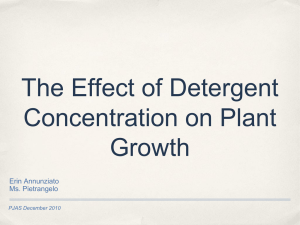Soaps and Other Detergents
advertisement
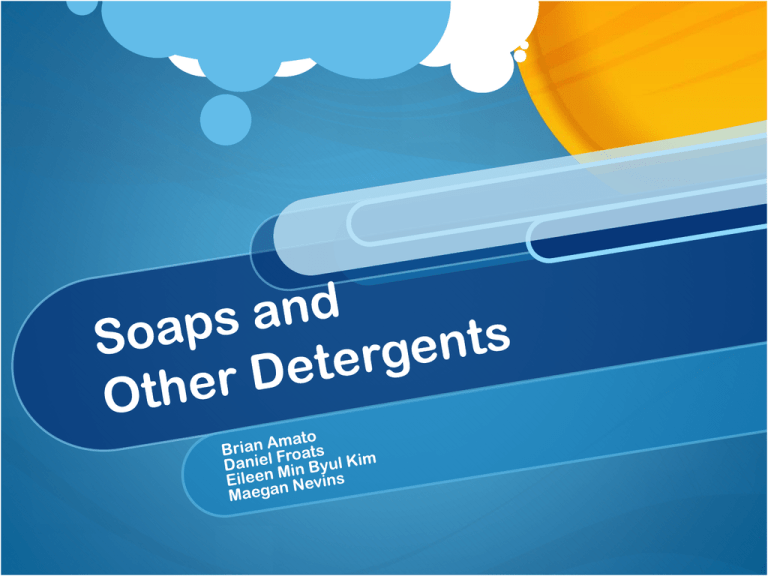
Agenda Introduction Industry Analysis Advertising Strategies Recommendations Why the Industry? Ad-to-Sales Ratio Highly Saturated Market Overall Spending Industry Definition Industry that produces substances that loosen and remove soil from a surface for personal hygiene, sanitation or cleaning clothes, linens and furnishings Major Products Primary Activities Manufacturing & packaging soap Preparing, manufacturing, and packaging cleaning compounds Industry Structure Market Share HHI = 562.7 P&G Calculated using top-5 companies Slightly skewed by “Others” of 54.6% of small other firms 20% 9% 55% C4= 40.5% 5% 6% 5% S.C. Johnson & Son Ecolab ColgatePalmolive Unilever PLC Others Top - 3 Players P&G S.C. Johnson & Son ColgatePalmolive Industry Structure The US soap and detergent manufacturing industry includes about 650 companies with combined annual revenue of about $27 billion The industry is highly concentrated: the top companies generate about 90% 50 of revenue Industry Structure: High Barriers to Entry – Medium Capital Intensity Competition Concentration Life Cycle Stage (Mature) Regulation and Policy Technology Change Industry Assistance Low Appropriate pricing strategy Development of new/innovative products Economies of scale Brand loyalty Industry Analysis: Supply contracts for commodity inputs Key Success Factors Marketing expertise Industry’s Products Multi-Purpose Products • Line extensions that serve multiple needs • Cross-selling strategies to take advantage of existing brand equity Specialized Products • Specialized products to generate growth in mature market Superior Customer Service • Offer help in safety and environmental regulation compliance • Provide maintenance services Industry Analysis Customer Segment Supermarket chains, mass merchandisers, drug stores, and warehouse clubs Commercial Segment Industrial and commercial laundries, hotels, restaurants, and healthcare providers Costs Producer Ingredient costs 35-40% of the wholesale price The price of surfactants and related chemicals can fluctuate and affect profitability Consumer Product Avg. Retail Price Laundry Detergent $5 Dishwashing Detergent $2 Soap $2.50 Producer Production Cost Consumer Consumption Cost Employment Due to the high level of automation at many manufacturing facilities, most production jobs require few skills Average hourly wages are slightly lower than the national average Industry Employment Growth Average Hourly Earnings & Annual Wage Increase Industry Trends Low growth in market volume and wholesale pricing drives manufacturers to increase productivity to cut costs High levels of automation and improved manufacturing technology have allowed soap and detergent manufacturers to increase output with fewer workers Imports and Exports The US is a net exporter of soaps and detergents; the value of exports is about twice that of imports. Main exports nations: Canada, Mexico, Japan, South Korea, the UK Most large companies have plants throughout the world. US soap and detergent exports increased more than 70% between 2005 and 2010. Role of Government Federal, state, local, and foreign environmental and safety laws regulate hazardous materials used or produced Some large companies are actively involved in cleaning contaminated sites due to past operations Some companies are reformulating products to meet demand for “green” products Why focus on P&G? Advertising Expenditure Highest Industry Market Share Diverse Product Offerings 11.5 11 P&G Ad-Sales Ratio Except for 2009 when it decreased by 0.79% This probably seems to be related to the financial crisis that happened late 2008 However, the ad-sales ratio soon recovered and P&G’s ad-sales ratio is higher than ever, being 11.28% in 2011 10 Percent P&G’s ad-sales ratio has continuously increased 10.5 9.5 P&G 9 Peer Avg. 8.5 8 7.5 2007 2008 2009 2010 2011 Primary Advertising Methods Informative “Slice of Life” Comedy Comparative Advertising Mediums Television Print Magazine Social Media Facebook, Google, Youtube, etc Social Campaigns Advertising Mediums and Effectiveness Percent Effect of ad on product awareness 100 80 60 40 20 0 Percent Effect of ad on knowledge 100 80 60 40 20 0 Effective Medium? Audio-visual media: TV, Exhibition, Window Display Print media: Newspapers, Magazine Advertised Products Advertised Products Tide: Liquid Laundry Detergent Tide Plus Bleach: Liquid Laundry Detergent • Count: 6,516 times • Total: $15 million • Average: $2,341 • Count: 5,318 times • Total: $12 million • Average: $5,413 Ad Spending by Day of Week Millions Sum of DOLS $14 $12 $10 $8 $6 $4 $2 $SUN MON TUE WED THU FRI SAT This seems to show a sign of Pulsing strategy While P&G airs TV ads continuously throughout the week, the most is spent on Tuesdays and Thursdays. Ad Spending by Day Part Millions 8000 7000 6000 5000 4000 3000 2000 1000 0 $35 $30 $25 $20 $15 $10 $5 $- Sum of DOLS Average of DOLS Most products were aired: Prime time > overnight > Afternoon Daytime 2 Most spent on Prime time (both total & average) While total advertising expenditure of overnight time was high, the average cost of overnight time was relatively low For afternoon daytime 2, it was rather consistent; all relatively high $5 $5 $4 $4 $3 $3 $2 $2 $1 $1 $- Thousands Ad Expenditure (Sum/Avg) Number of Products Advertised $45 $16 $40 $14 $35 $12 $30 Thousands Millions Ad Spending by Network $10 $25 $8 $20 $6 $15 $10 $4 $5 $2 $- $Cable TV Network TV Sum of DOLS Average of DOLS2 SLN TV Total advertising expenditure highest for Cable TV However, on average, Network TV is the most expensive, then SLN TV, and Cable TV is the cheapest Ad Spending by Program Types Number of Products Advertised 8000 7000 6000 5000 4000 3000 2000 1000 0 $14 $12 $10 $8 $6 $4 $2 $- $10 $9 $8 $7 $6 $5 $4 $3 $2 $1 $- Thousands Millions Ad Expenditure (Sum/Avg) Sum of DOLS Average of DOLS Focus mostly on Slice-of-Life, Soap Opera, Feature Film, and Situation Comedy Award/Celebration? Average is highest; count and sum is very low AdImpact by Program Type High Performance? Detergent: feature film, general drama, and news Specialty soaps: popular music, instruction/advice offerings TV Ad Content Analysis 83% 83% 83% 50% 1 Sustainability 11% Informative Contained Elements of Comedy "Slice of Life" Advertised Comparative Multiple Tide Products “My Tide” Campaign “Tide Dad” Informative ad Highlighted attributes: good on children’s clothing, tough on stains and preserves the original look & feel of clothing “Dad’s Designer Jeans” Informative ad Highlighted attributes: preserves the original color of fabric, good on delicate fabric and high quality clothing How is P&G Different? Proctor & Gamble’s strategy of targeting several strategic niche markets The power of storytelling Strong brand value & brand equity Print Advertising Medium With Reliable Metrics Innovative Ad Campaigns Shift in Spending Toward Magazine Ads Benefits of Targeted Media Coupons/Promotions “Loads of Hope” Disaster Strikes “A disaster occurs making relief necessary for the families affected” Help is Sent “We send our mobile laundromat fleet to the location” Laundry is Provided “We spend multiple days at the disaster site washing, drying and folding clothes for the families affected” Social Media “As we’ve said historically, the 9% to 11% range [for advertising as a percentage of sales] has been what we have spent. Actually, I believe that over time, we will see the increase in the cost of advertising moderate. There are just so many different media available today and we’re quickly moving more and more of our businesses into digital. And in that space, there are lots of different avenues available. In the digital space, with things like Facebook and Google and others, we find that the return on investment of the advertising, when properly designed, when the big idea is there, can be much more efficient. One example is our Old Spice campaign, where we had 1.8 billion free impressions and there are many other examples I can cite from all over the world.” –Robert McDonald, CEO “Future Friendly” Program/Sweepstakes Facebook Based Sweepstakes Celebrity Endorsement Interactive Campaign Special Events Recommendations Target Growing Hispanic Population Focus on More Targeted Media Innovative Use of Social Media P&G: Great Long-term Investment P&G has an aggressive global growth plan for the emerging markets in the years to come Company Goal: 1 billion new customers by 201415 New Manufacturing facilities in Brazil, Eastern Europe, India, and China P&G: How to Accomplish Future Growth New plant in Luogang China Up and running by 2013 $490 million in product revenue Reducing Costs: phase out non-manufacturing jobs in the U.S 5700 layoffs helping the company reach its goal of 10 Billion in cost cutting measures by 2016 P&G: How to Accomplish Future Growth The Market for the poor is not highly-saturated Africa: To capture the market in Africa, P&G is selling “no frills”(non-essential features removed) versions of its products in smaller sizes that eventually will add up Persuade people who live on $5 or less a day to buy P&G items By locking up 10-20% of sales in "the company's top 30 emerging markets would add $5.9 billion in new sales in five years



